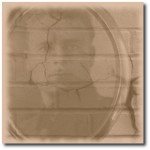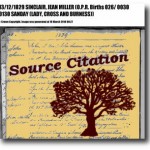Search results
Donating Genealogical Records
June 28, 2012 by ramona
Filed under Articles, Latest News, Preserving Your Family Tree
 Have no doubt that your family tree research has value beyond the current generations of your own family.
Have no doubt that your family tree research has value beyond the current generations of your own family.
Donating your family history to a local historical or genealogy group is an excellent way to make certain all of your hard work is put to good use. Local Historical Societies and Genealogy groups have a stake in preserving your records for future generations.
How to Donate Your Family Tree
If you are considering donating your family tree research the best place to start is by contacting your local library. Your local library can help you identify the archives that are best geographically suited to receive your family’s story.
Generally, community groups are interested in local reference records. However, they may have ties to other groups with broader interests such as provincial or state archives.
When donating a rather widespread family tree it may be worth considering breaking it into smaller portions focusing on specific locations.
While it is normal in a large family tree to have a significant geographical spread with ancestors coming from all corners of the globe, a local group may have limited space. Therefore, it is reasonable that they may not want to house large documents unless they are completely location specific.
What to Include with Your Donation
Along with your family tree templates or pedigree charts, you should include either originals or copies of:
- Primary and secondary source documents
- Old photos
- Vital Records
- Newspaper clippings
- Maps
Donating your family tree data is one of the best ways of sharing your genealogy and contributing to the preservation of history in your community. Not only does it help preserve your research for future generations it may be key to helping another family history researcher to break down a brick wall.
However, before you donate be sure not to part with any original items you or other members of your family may want to keep. Lastly, make certain that all of your research conforms to The Big Five Genealogy Standards and Guidelines.
To learn more about genealogical standards sign up today for Genealogy Beginner’s 30-day free trial and receive Eight, Step-by-Step Weekly Lessons You Can Do At Your Own Pace. Starting with Lesson 1: Genealogy Standards And Guidelines.
Genealogy: Getting to Know Your Ancestors
June 14, 2012 by ramona
Filed under Archives, Family History, Genealogy groups, societies and organizations, Latest News
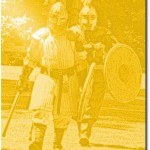 The Merriam Webster Dictionary gives a definition of genealogy as:
The Merriam Webster Dictionary gives a definition of genealogy as:
- an account of the descent of a person, family, or group from an ancestor or from older forms
- the study of family pedigrees
Strictly speaking, this is true; it is certainly a good definition of the process and an accurate descriptor of the intent with which genealogy is first approached. However, to those of us who have spent any length of time on this addictive hobby, the study of our ancestors begins to take on new meaning.
It is not long after family tree research begins that the dry definitions become inadequate. As we work our way through record after record, learning piecemeal the details of our ancestors lives we begin to feel we are getting to know them as individuals.
For some, the genealogical aspects of family history research are not enough. We want to get to know our forefathers on a deeper level. Become more familiar with their day-to-day lives.
If you count yourself among those wishing for a deeper understanding of your generations past, there are a number of activities you can participate in; activities that will allow you to experience your family history in a very real way.
Recreationists
Pick almost any period in history and you will find a group of people actively recreating the era. Living history groups include the activities, dress and tools of the eras they portray to give participants the sense of stepping back through time. Recreationists are not re-enactors; they are not scripted nor are they involved in recreating specific events. Member’s interests can include clothing styles, pastimes, cookery and artisanship, everything that would help create a feeling of every day life in bygone days. It is not at all surprising that among their ranks you find many genealogists and family historians.
Living History Groups
From late 20th century groups like “The 20th Century Revisited” A UK based group recreating scenes and events from various parts of the later 20th Century including WW2 resistance, and 1970 British Army of the Rhine (BAOR) or “Paper Dolls” An international group made up of female members who portray military and civilian life during World War Two. From hometown sweethearts, Women’s Land Army, French Resistance, American Red Cross, Women’s Army Corps. These groups offer an opportunity to learn what it was like for ancestors who lived during the great wars; both on and off the battlefield.
If you are more interested in the events of the 19th century The Living History Society of Minnesota members can attend workshops and participate in activities designed to increase their knowledge of mid 19th century life. For those whose Gr,Gr,Gr, Grandfathers heeded the familiar call of “Go West young Man” the Mojave Muleskinners have several branches across the US, Canada and the UK where you can immerse yourself and learn about life in the old west.
If you can trace your family tree to medieval times, a living history group from the Middle Ages may be more suiting. The Society for Creative Anachronism (SCA) is an international organization with over 30,000 members residing in countries around the world. One of the best things about this group is that you will find a mix of cultures from Viking to Italian to Middle Eastern. Members attend events such as tournaments, royal courts, feasts, dancing, various classes, workshops and more. The SCA is a group that lets you explore all of the European lines in your family tree.
If you want to know more about how living history groups can help enrich your genealogy and family history or how to find a group near you, just post a question to the Genealogy in General board on the Genealogy Beginner forums.
Genealogy Scams and Red Flags
April 22, 2012 by ramona
Filed under Articles, Getting Started in Genealogy, Introduction to Genealogy, Latest News
 With the growing popularity of genealogy and family history, it is easy to find hundreds of internet sites dedicated to the subject; from sites claiming to have huge databases to others that promise to contain information relevant and specific to your family tree, surname or coat of arms.
With the growing popularity of genealogy and family history, it is easy to find hundreds of internet sites dedicated to the subject; from sites claiming to have huge databases to others that promise to contain information relevant and specific to your family tree, surname or coat of arms.
Beginning Genealogists should be aware that not every genealogy site is as good as the claims they make.
Genealogy Scams
While a great deal of family tree sites are trustworthy, newcomers to genealogy can sometimes fall prey to less reputable sites that exist to take your money and offer you zero results or results you could have found for free. Additionally family tree research novices should beware of “genealogy sites” that exist for the sole intention of gathering your personal information for the purpose of email marketing or worse…identity theft.
Before you enter your details for any family tree site, research the site to see what they are claiming to offer.
A reputable genealogy site will:
- List exactly the information, records and databases you can access once you have signed up
- State the locations and periods for which records are available
- State the source of the records or information they hold
Top Three Genealogy Site Red Flags:
#1. A site that makes generalized claims such as “Largest Genealogy Database”, “Millions of Names Free”, “Your Family Story” or simpler claims to “marriage or birth records” without any detail provided…should be avoided.
#2. Your “Free Search” results are ambiguous. For example, a search return that says they have found X-number of results on the name you entered without details. A good test of this kind of result is to type in a nonsense name such as Harry I. Balls or Jemima Pancakes to see how many results you get.
#3. A site that only provides an online contact form and does not list contact information such as a telephone number or address is not a good bet. A site without customer service is an absolute no go.
Although there are no 100%, fail-safes as these sites tend to come and go rather quickly. Following the above mentioned simple precautions may help you spot Red flags and make adding those names to your family template a safe and enjoyable experience.
Genealogy Brick Walls: Look In the Unlikely Places
March 18, 2012 by ramona
Filed under Articles, Genealogy Searches by Place, Introduction to Genealogy, Latest News
 Hitting a brick wall in your family tree is an extremely frustrating experience for every family tree enthusiast from the novice to the advanced. Especially after, you have spent hours combing through all of the obvious records. When you have already checked the church records, civil records, obituaries, newspaper archives, immigration records and census…do not give up. Just realize that it is time to pull out your shovel and start digging deeper.
Hitting a brick wall in your family tree is an extremely frustrating experience for every family tree enthusiast from the novice to the advanced. Especially after, you have spent hours combing through all of the obvious records. When you have already checked the church records, civil records, obituaries, newspaper archives, immigration records and census…do not give up. Just realize that it is time to pull out your shovel and start digging deeper.
In short, after you have looked in all of the likely places the only places left to check are the unlikely ones.
Genealogy in the Unlikely Places
The unlikely places are usually the ones you ruled out your first time through. You may be very surprised at how much information you can find by looking in records that seemed irrelevant or illogical to your family tree research.
Finding Ancestors in Land Records
You have ruled this out because your ancestor did not own land, but did you know you could still find the record of a lease for a tenant farmer or rental agreement for your Great, Great Grandma’s city home.
Your Family Tree and Depositions
You have probably already checked the immigration records to see if your ancestors changed their name upon landing in the new country. However, did you know that many immigrants did not change their names until they were already naturalized citizens? If your ancestor decided to change their name after becoming a naturalized citizen, you would find this information in court records as depositions.
Name changes of this type often happened because immigrants felt a foreign name made their lives more difficult in their new home. If your ancestor has pulled a disappearing act, searching depositions for name changes would be a good place to start.
Historical Societies and Genealogy
Your local historical society (or the local historical society where your ancestor lived) may hold the clues you have been looking for. Historical societies are notorious for holding little known documents and unpublished works that are only listed within their collection.
One Family Tree Search is Never Enough
Newspaper archives may be something you have already checked. Nevertheless, you should try them again. Many genealogy beginners give up far too soon on this information source by stopping at a single search type. Any search of a newspaper archive should be undertaken with three search strategies.
- Search by Name
- Search by Date
- Search by Location
A newspaper can hold so much information in a single issue that not all names are indexed. That is why a three-tier search is necessary.
Although sometimes a brick wall in your genealogy research is due to records being lost in fires and wars, poor preservation and/or the records were simply not kept. The biggest problem with brick walls is that family enthusiasts either give up too soon or just don’t know where to look next. Should you have any questions or want a little extra help tackling your brick wall, please feel welcome to post your questions to the Ask a Genealogist forum. Genealogy Beginner looks forward to hearing from you.
Image Credit: Ramona Hartley
Genealogy Brick Walls: Look In the Unlikely Places
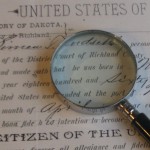 Hitting a brick wall in your family tree is an extremely frustrating experience for every family tree enthusiast from the novice to the advanced. Especially after, you have spent hours combing through all of the obvious records. When you have already checked the church records, civil records, obituaries, newspaper archives, immigration records and census…do not give up. Just realize that it is time to pull out your shovel and start digging deeper.
Hitting a brick wall in your family tree is an extremely frustrating experience for every family tree enthusiast from the novice to the advanced. Especially after, you have spent hours combing through all of the obvious records. When you have already checked the church records, civil records, obituaries, newspaper archives, immigration records and census…do not give up. Just realize that it is time to pull out your shovel and start digging deeper.
In short, after you have looked in all of the likely places the only places left to check are the unlikely ones.
Genealogy in the Unlikely Places
The unlikely places are usually the ones you ruled out your first time through. You may be very surprised at how much information you can find by looking in records that seemed irrelevant or illogical to your family tree research.
Finding Ancestors in Land Records
You have ruled this out because your ancestor did not own land, but did you know you could still find the record of a lease for a tenant farmer or rental agreement for your Great, Great Grandma’s city home.
Your Family Tree and Depositions
You have probably already checked the immigration records to see if your ancestors changed their name upon landing in the new country. However, did you know that many immigrants did not change their names until they were already naturalized citizens? If your ancestor decided to change their name after becoming a naturalized citizen, you would find this information in court records as depositions.
Name changes of this type often happened because immigrants felt a foreign name made their lives more difficult in their new home. If your ancestor has pulled a disappearing act, searching depositions for name changes would be a good place to start.
Historical Societies and Genealogy
Your local historical society (or the local historical society where your ancestor lived) may hold the clues you have been looking for. Historical societies are notorious for holding little known documents and unpublished works that are only listed within their collection.
One Family Tree Search is Never Enough
Newspaper archives may be something you have already checked. Nevertheless, you should try them again. Many genealogy beginners give up far too soon on this information source by stopping at a single search type. Any search of a newspaper archive should be undertaken with three search strategies.
- Search by Name
- Search by Date
- Search by Location
A newspaper can hold so much information in a single issue that not all names are indexed. That is why a three-tier search is necessary.
Although sometimes a brick wall in your genealogy research is due to records being lost in fires and wars, poor preservation and/or the records were simply not kept. The biggest problem with brick walls is that family enthusiasts either give up too soon or just don’t know where to look next. Should you have any questions or want a little extra help tackling your brick wall, please feel welcome to post your questions to the Ask a Genealogist forum. Genealogy Beginner looks forward to hearing from you.
Image Credit: Ramona Hartley
Genealogy Brick Walls: The Problem of Names
March 8, 2012 by ramona
Filed under Articles, Genealogy and Surnames, Introduction to Genealogy, Latest News
Nothing can stop your family tree research in its tracks like not being able to find your ancestors records. Usually, this boils down to the big four problems of names.
- Common names give too many options
- Spelling variations lead to confusion
- Misspellings can frustrate your efforts
- Indexing errors…are a fact of genealogy research
Brick Wall Problems with Common Names
The issue with common names is that they offer too many possibilities. If your ancestor is Joe Smith or Ole Olson your main question is going to be which one is mine? For example, a quick search for Ole Oleson, born 1830 in Rendalen, Norway, returns 632 records. You are going to need to employ some hard-core search strategies to find your Ole Oleson.
Brick Wall Problems with Spelling Variations and Spelling Mistakes
At the time of the early census there was no standardization for the spelling of names, consequently names were often spelled phonetically. Add to this the fact that not everyone had access to education (your ancestor may not have been able to spell or write their name) and it is not hard to imagine why we come up with so many variations on a single surname.
Another common problem of the time was simple human error. Spelling mistakes occurred frequently and for the same reasons as stated above. Additionally, immigrant ancestors may not have had a strong enough grasp of English to catch errors or perhaps the census taker had a difficult time understanding them.
On the other hand, they may have altered their name to a more anglicized version or changed it altogether.
Brick Wall Problems with Indexing Errors
Thank goodness for the volunteers who spend hours transcribing documents, these wonderful people are the ones responsible for making records readily available to family tree enthusiasts. I would never fault them for their efforts. If you have ever spent time as a volunteer indexer you would agree, old writing is sometimes so faded or illegible that mistakes are unavoidable.
In spite of the problem of names, brick walls can be annihilated. Here are a few approaches you can use to overcome them.
Brick Wall Genealogy General Rules of Thumb:
- Use Wild Card and Boolean searches
- Make a list of all possible spellings of your ancestor’s surname
- Find an ancestor with an uncommon first name and search with that to find your family
- Combine your search to include a spouse’s name
Common names, surname variants, misspellings and indexing errors while problematic are not insurmountable. Using some of the above brick wall tips combined with a sound research strategy read (Brick Wall Breakthroughs for Genealogy Beginners) will give you the tools to break down your brick wall and move forward with your research. Join us in the forum Ask a Genealogist where you will find four key strategies to solving your brick wall problem with names.
Image Credit: Ramona Hartley
How to Cite Family Tree Information Sources
March 2, 2012 by ramona
Filed under Articles, Genealogy Standards & Guidelines, Introduction to Genealogy, Latest News, Lesson 1 Articles
As a family tree enthusiast, you are probably aware that your genealogical information comes from multiple places such as government agencies, Old Parish Records, monumental inscriptions, online genealogy sites, books and newspapers. No matter where you found the information about your ancestors it is simply good practice to cite your sources. The basics of citing a source are simple.
Citing a Genealogy Source Consists of Naming:
- Who created the source (publisher, historical society, government agency)
- What the source was titled (John O’ Groat’s Journal)
- When the information was created (copyright or year of publication)
- Where the information was created (State, County, and/or name of publisher)
- How you found it (name of repository or archive)
- Why it is a good source (primary, secondary or tertiary source)
Citing sources is particularly important if you plan to publish your family tree to the internet and it helps all of us involved in family tree research to sort out the reliable information from assumptions and guesswork.
Citing Sources for the Genealogy Beginner Citing sources can also be time consuming and confusing if you are not familiar with how to cite properly a source of genealogical information. For starters, here are some general helps and guidelines to citing a source.
Genealogy Citation Guidelines:
- <angle brackets> are for internet addresses <https://www.genealogybeginner.com/>
- [brackets] are for descriptive information
- Information about publishers should be in
- (parentheses)
Always cite exactly what you have found along with where you found it If you have doubts either leave it out or note is as a supposition.
For example in the case of a Monumental Inscription:
PETER SINCLAIR, CATHERINE CALDER Erected By Peter Sinclair In Memory Of His Wife Catherine Calder Who Died At Greentoft, 21st March 1905, Aged 72 Years. Also Peter Sinclair, Born At Cleat, Sanday, 12th June 1830, Died At Greentoft, Eday, 3rd January 1917
Citation:
Orkney Family History Society , “Orkney Graveyard Search for: Sinclair in Eday & Pharay, Old Kirkyard, St Marys, Eday Orkney” (Orkney Family History Society ) [Ray Millar ] <http://www.orkneyfhs.co.uk/mis/minscriptions.php?opt=gyard&gref=151&surname=Sinclair> Report date: 04/03/12
note: Eday, Orkney, Scotland: Eday Old Kirkyard, Orkney, Scotland Plot: 329
It also helps to become familiar with the abbreviations used in citing your family tree information sources along with the standard formats used. Standard
Abbreviations for Genealogical Citations

Standard Format for Online Genealogical Citations
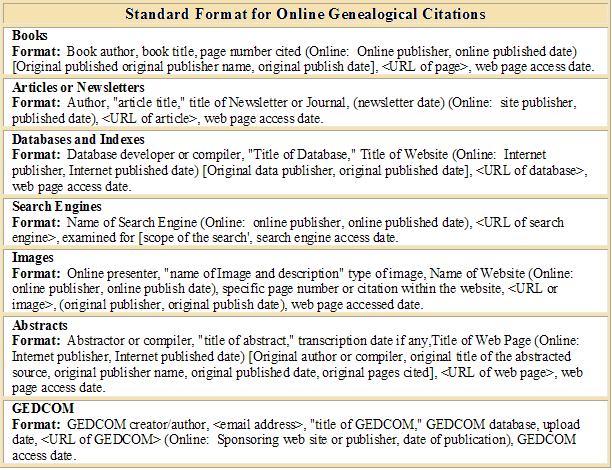
Citing your sources will give you the confidence to publish your family tree knowing that all of your hard work is beyond reproach. You can learn more about the importance of citing your family tree research and genealogy best practices in Genealogy Beginner’s Lesson 1: The Big Five Genealogy standards and guidelines: what you need to know first
Image Credit: Ramona Hartley
Genealogy: Crests, Coat of Arms and Surname Origins?
February 24, 2012 by ramona
Filed under Articles, Genealogy and Surnames, Introduction to Genealogy, Latest News, Lesson 5 Articles
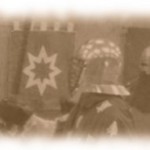
Have you ever searched for your surname in Google and come across websites for Family Crests, Coat of Arms and Surname Origins? If you are a genealogy beginner, you may even have gone to the website for information on your ancestors.
The real question here is how much value do these types of websites offer as a reliable source of information for your family tree research?
Surname origin websites, although highly entertaining and interesting, rarely have the information you really need. Many of them sell pre-written generic genealogies based on surname origin. Sadly, these genealogies often have nothing to do with sound family tree research and they can be misleading to those new to genealogy.
Surname Origins
For our first example, let us look at surname origin or surname history sites. Using the name Clegg in a Google search and randomly picking three sites, I find the following.
- The first site states that the Clegg surname “makes an impressive claim to being one of the oldest Anglo-Saxon surnames on record”. Then goes on to say the origins for the name hail from the “Rhine valley as far north east as Denmark”
- The second site surmises the Clegg surname is of English origin and comes from the Old Norse word “Kleggi” meaning at the foot of Owl Hill.
- A third surname origin website tells us that Clegg is an anglicized version of the Gaelic name “Mac Liaig(h)” which evolved into “Claque” and from there to Clegg. This site tells us that the name originates on the Isle of Mann.
From the above examples it is easy to see that while there may be a great deal of research and at least a grain of truth to each example, ultimately the information is contradictory and confusing. Therefore, while we all would like to know the origin of our family names Genealogy Beginner advises that it is best to regard these types of genealogy websites with a wee bit of skepticism.
Family Crests and Coat of Arms
Crests
A family crest historically is part of a family Coat of Arms or heraldry. It is called a crest because it was mounted on the top of a helm above the shield on a Coat of Arms. By the 13th century, a crest was used as a means of identification in tourney (think the movie – A Knights Tale) or on the battlefield.
Coat of Arms
A Coat of Arms also began as a way to identify an individual on the battlefield. Coat of Arms literally gets its name from a coat worn over armor or chain mail and was used initially to protect the armor or keep it cool under the hot sun during the crusades. Later it was decorated with identifying colors and designs in order to help distinguish friend from foe.
Ultimately a Coat of Arms is:
- An Armorial right that must be granted under due authority
- Usually the Crown or State
- Some governments (Canada) have the authority to grant the right.
Alternately, the right to bear arms can come from decent or “by virtue of ancestral right”.
What all this really means is that a coat of arms belongs to a direct family line and any website that tries to sell you your Coats of Arms is selling you a generic product that may or may not have anything to do with your lineage.
Overall, there is no real harm in surname origin or Coat or Arms websites so long as you are not misled into believing that they are an authority on your individual family tree. If you really want to know the origin of your surname (or whether or not there is a Coat of Arms associated with it) you will have to put the hard work into tracing your family tree as far back as you can, using well-established genealogy research techniques.
For more information on surname research, check out Genealogy Beginners Lesson Five: What’s in a Name?
Image Credit: Ramona Hartley
“Who Do You Think You Are”, Episodes 1 & 2: Family Lore
February 16, 2012 by ramona
Filed under Articles, Genealogy Military Records, Genealogy Records 101, Latest News
 “Who Do You Think You Are” begins each episode by saying “To know who you are, you have to know where your story began”. Those words could not ring truer than in the first two episodes of season three.
“Who Do You Think You Are” begins each episode by saying “To know who you are, you have to know where your story began”. Those words could not ring truer than in the first two episodes of season three.
Episode One: Martin Sheen
With a colorful history of his own, Mr. Sheen has made headlines for his efforts as a civil activist supporting issues from liberal politics to environmental concerns. It was hardly a surprise to learn that his passionate outspoken nature may stem from ancestral roots on both sides of his family.
Mr. Sheen begins his genealogy journey with a little family lore. The subject of this family tree investigation is Michael Phelan, an uncle on his mother’s side, who was reportedly a volunteer in the Irish Republican Army.
To help Mr. Sheen uncover the truth behind the family tale, “Who Do You Think You Are” applies a number of research methods and utilizes all relevant resources.
In the first part of this episode, we see genealogical research conducted through an examination of:
The discoveries made during this systematic process uncovered an unexpected truth. For years, Mr. Sheen’s family had believed that their legendary ancestor fought on the side of the IRA. However, his visit to the Military Archives revealed that Michael Phelan actually fought for the opposing side…the Irish National Army.
Episode Two: Marisa Tomei
Marisa Tomei was the guest on the second episode of “Who Do You think You Are” season three. In this episode family lore also plays a big part in the Tomei family’s desire to dig in to their past.
The subject of the story is Marisa’s Great Grandfather Leopoldo, who was murdered for uncertain reasons. Family legend hints that the murder was motivated by a possible love affair or a debt he owed, shedding an unflattering light on this notorious ancestor.
As the Tomei story unfolds, “Who Do You Think You Are” takes us on a trip to Italy where Marisa wades through a maze of documents, research resources and consultations with experts who help her to examine:
However, before she leaves Marissa visits her mother who has uses a well know genealogy database to make a family tree.
Perhaps one of the most enjoyable components of family tree research is the family history aspect. Learning the truth behind stories passed from generation to generation. Often these stories have a grain of truth, rarely is it ever the whole truth as we see in the first two episodes of season three.
If you missed this episode of “Who Do You Think You Are”, join us in the forum The Discovery Panel for a link to where you can watch the episode online free. You didn’t think I was going to ruin the ending did you? Also, join us for a genealogy research tip based on the first two episodes.
Image Credit: Rav 7 Via Photobucket
What is a Resident Genealogist?
February 10, 2012 by ramona
Filed under Articles, General Tips, Getting Started in Genealogy, Introduction to Genealogy, Latest News
 A resident genealogist is a professional on staff at a library, archives or even on a genealogy website who is there to provide family tree research advice and guidance, particularly to genealogy beginners. A quick question to the resident genealogist may save you time as well as a great deal of frustration and it can be a lot of fun.
A resident genealogist is a professional on staff at a library, archives or even on a genealogy website who is there to provide family tree research advice and guidance, particularly to genealogy beginners. A quick question to the resident genealogist may save you time as well as a great deal of frustration and it can be a lot of fun.
If nothing else your Genealogist in Residence is almost certainly, part detective and part historian. A website with a resident genealogist is showing you how much they care about you, their members and how important it is to them to help you in every way they can.
What Does a Resident Genealogist Do?
A resident genealogist:
- Searches out new genealogy resources
- Provides educational materials
- Writes articles about genealogy
- Answers questions about family tree research
- Can help genealogy beginners to understand genealogical documents
- Provides tips and inspiration to keep you motivated
The primary duty of a resident genealogist is to help you learn to conduct your own genealogy research.
How can a Resident Genealogist Help Me?
When you have hit a brick wall a resident genealogist can help you find more resources or make suggestions on where to look next. If you are having a difficult time understanding your ancestor’s birth, marriage or death certificate, a resident genealogist is always happy to help. Any problem you come across is like candy to a resident genealogist, so do not be shy about asking.
What Kind of Questions can I ask?
You can ask any questions you need; no question is too big or too small. When asking your question include the details, give the names dates and places of the ancestor you need help with. State why reading a particular document is a problem, is the writing is too faded or messy. Want to know what a third cousin twice removed is or what all those numbers on a Family Tree form mean…just ask!
Genealogy Beginner encourages you to go to our resident genealogist with your questions. You can usually find her on the Ask a Genealogist forum or on our Facebook page.
Image Credit: dbickert via Photobucket

